
OHIO TOWN – varnish on figured foam – 2005
You, especially if you patrol the aisles of building supply stores, have run across sheets of a light, pink material, used for insulation. Foamula is a common trademark.
This material, albeit soft and yielding, has found a structural use in the building trades. It, and things like it, are carved or cast into architectural shapes and then coated with a firmer material to give fake pillars, ashlar treatments, cornice features and the like.
In an experimental mood I bought a Foamula board. While tossing the stuff around, I decided to see how it reacts to heat. I applied a torch to it and it shrank. Next, I masked off some areas of the board and applied a torch to it. The torch had a greater effect upon the unprotected areas, leaving a pattern of relative highs and lows. For greater control I substituted a paint removal gun – a more powerful version of a hair dryer – and found myself with things to do.
The following is a brief description of the technique. In this demonstration I start with a fresh sheet. Imagine a featureless pink rectangle.
The blank sheet mocks and teases, as would any good canvas – except it does so in a Pepto-Bismol way.
My first decision is to use mud as the covering agent. The mud around here is clayish, free and ultimately recyclable. Furthermore, it seems to have the nicest relationship with the surface of the Foamula. How to handle the mud? In one scenario I would have spread it around and then have done a big finger painting. In another, I would have taken a leaf rake to the surface and produced wavy patterns. Ultimately, I recruited cut-wood elements, destined for other uses.
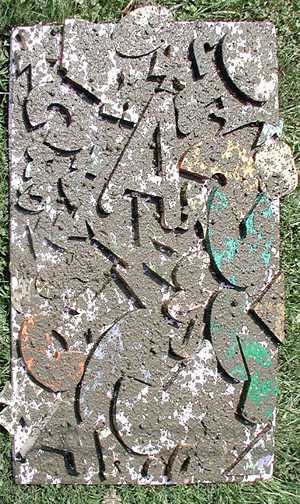
These I put about and splattered with the mud.
I then gingerly removed the wood and applied the paint remover gun.
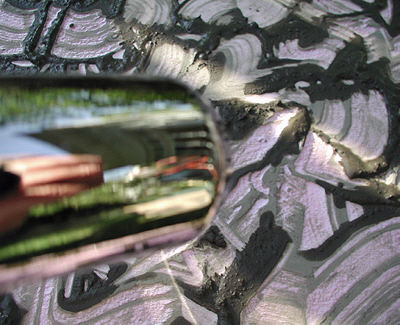
This shot is of another project, but I like its looks. I then wash off the mud leaving a pattern of islands and depressions that are anywhere from a quarter to a half inch deep.
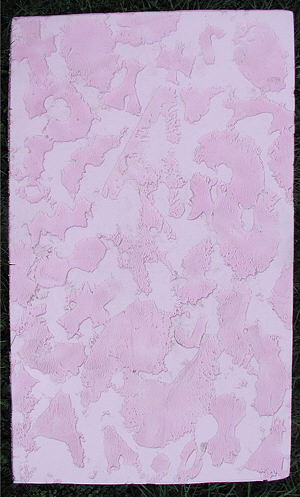
Now I need to make sense of what is somewhat random and unresolved. The overall pattern is a given, unless I want to dig in again. But many interpretations are possible. I have taught myself not to have a crisis as I can go over the sheet repeatedly with different approaches.
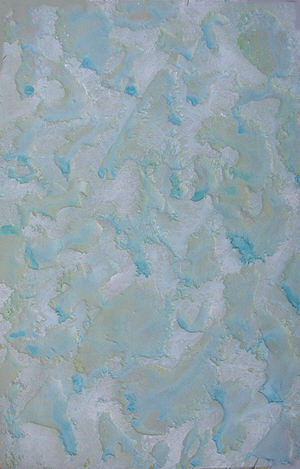
In this iteration I have washed the image in layers of colored and diluted primer. The whole thing reminds me of an archipelago, but I will resist the impulse to turn it into a kind of Indonesia. I feel that I may be done with the primer, as the surface is now pretty well protected against any unwanted interactions of varnish and foam. In direct sunlight and with any solvent, the varnish can begin to dissolve the foam. This may lead to strong results, as the foam then sets up hard. But one must accept an element of unpredictability.

At this juncture I have begun to add varnish, which has pooled and flowed. I have also rubbed colors over the plateau surfaces. The painting is full of effects. One compromising aspect is the composition of shapes, which is neither vague nor specific enough. Is this a killer? Possibly. Whatever its shortcomings, this exercise serves to illustrate some of the issues that one might encounter.
I can go in some known directions. One is to do as I have done too much and paint the entire surface in one color and go over the entirety with a tinted clear glaze. Another is to deal with depressions as one domain and the plateaus as another and give each aspect a different color treatment. As matters stand, the painting is mumbling to itself and we’re not on speaking terms yet. This socialization process is bound to go beyond the deadline for this post. So, in closing, let me put up something that I did recently.
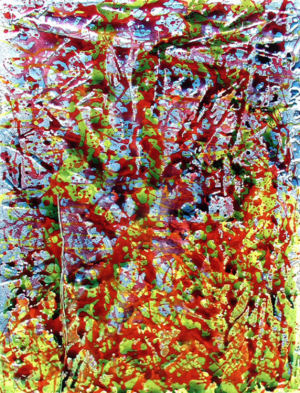
This is a splatter painting using tinted glazes over a figured background of a greenhouse plant.
Also, the three-faced self- portrait included in “Face Off With Sunil” is painted and clear varnished on foam.
Is anyone inclined to try this technique? I sure would like to see your results.

If anyone can top this for non-traditional material and technique, I’d like to hear about it! Between the mud and the torch, I guess an outside studio is recommended.
Jay, your approach seems to involve a fair amount of chance and the artist’s response to it. I’m wondering if the material can also be manipulated in a controlled way by using a brush with some organic solvent that “melts” the foamula. If the properties are right, one could imagine “painting” a bas-relief sculpture. Have you ever tried that?
Steve:
Thanks.
The torch was a one-time thing. Aside from the hot air gun, there are other ways to get into the surface. Remember, the Foamula is soft at the outset and one can create grooves and depressions by dragging most anything across the board. I’ve used a knife edge and then rubbed paint into the fine groove. The paint acts as a buffer,like the mud in the demo. An application of the air gun shrinks the surrounding foam, leaving a clean ridge. One can essentially use the Foamula as a drawing medium with the option of working the piece in three dimensions.
Yes,one can also employ solvents to melt the surface. But that requires a deft touch and a lot of patience. One common problem is the tendency of the foam to undercut a design, leaving shapes to sit above the surface like toadstools.
I would think that any interior area suitable for throwing pots would also do for throwing mud. I work outdoors because we have a large back yard.
I believe that I’m part of a last gasp in handicraft. Companies are already coming out with x,y,z cutting tables and deposition tools for the home market that will allow one to transfer designs from the computer to the forming equipment much as one now sends work to the printer. Fabricators have been using computer controlled cutters to shape foam objects for many years.
Working outdoors is good. Be careful of the fumes when heating foamula.
Birgit:
I agree. The techniques I outlined should be attempted outdoors or in a well-ventilated area.
Now you tell me! I was passed out in my basement for 3 hours! ;-)
Really interesting techniques!
Andre Masson used to throw sand at white gesso and then scrape or sift until the excess dropped off and wondrously watch shapes beginning to form in the ensuing canvas. Oftentimes he would see landscapes and other forms. Your exercises with foamula reminds me of such adventures.
The plateaus and the depressions in the image (above the splatter painting) are very compelling. It reminded me of a time when flying back from our honeymoon from Turks and Caicos, I looked out the window and saw a lot of shimmering land forms and sand spits from the air. The negative space left by the islands on the serene sea was a sight to behold. I felt somewhat similar when I looked at this image (except in this case, your islands were teeming with vegetation with copper mines leaching the viridians).
I take it that the processes you go about to achieve these results are not formulaic but foamulaic.
Tree:
Are you sure that was the reason? If so, it must have been intense and well worth writing a post about.
Sunil:
A good bottle of Andre Masson and I can be up for a little sand kicking myself. And the pink elephants that soon appear might just be Foamula.
I don’t get that last thing you said.
I hope that ‘Well-Ventilated’ does not just mean opening a window but rather a motor sucking out the exhaust. Before the use of high power fume hoods, organic chemists had a short life expectancy. Also, an organic chemist told me that exposure to fumes correlates with Alzheimer’s disease. I did not check up on that claim.
I am revealing one of my personality traits, fear of toxins in the working place.
Jay,
Nothing serious. Just a play on words on a tornado struck NY afternoon. Thought it will liven things up.
‘formulaic but foamulaic’
Sunil:
Feigned bafflement. Very good pun. Wish I had thought it up.
Jay,
As you know, I’ve watched you working with this stuff for some time now. So I have the sticky questions all lined up. I know you love “material” — your joy is in the “stuff.”
But I have to ask rather rudely, “so what?” What place does meaning have in your pursuits? Where are you going with these once you have resolved the technical problems? Or is that the end point — the resolution of technical difficulties?
You know me — like Sunil, I’m always wanting some kind of verbalized “meaning.” I think your ladders clearly are meaningful. I have inklings about the wooden chains. But I have no insights about the foam work — it varies greatly — sometimes map-like, other times, architecture in fog, and so forth. What can you do with foam that you can’t do with wood or paint or linoleum glued to canvas?
June:
Not rude at all. Well…
It would be good if your questions could be simply answered – but they can’t.
“Stuff” is o.k., but I have little joy in it per se. The comment about “technical problems” is more to the point as I am drawn to their solution. Usually the technical problems are problems because I can’t find published answers and I must experiment. I’m surrounded by little bits of this and that – some of which could be patented – which are, for all intents, answers waiting for questions.
But wait – there’s more. What you are seeing is a sorting-out process underway where I am looking everything over. Ladders? The purest things I have ever done. Took a lot of time and effort to achieve that simplicity. There’s more to be done and I could become Hoffman the Ladder Man. But the Daniel Boone in me isn’t happy with that as it could be another forty acres and a mule. But it remains a real potentiality and I reserve the option to go back to it.
The linkage theme holds me. Technical problems galore, but I’m solving them. The whole thing keeps getting richer for me and the way forward for me is as clear as it is mysterious. Think Wright Brothers.
Then there’s extruded polystyrene foam. It’s fun. I get to try out things. If it seems to lack a focus, then so be it.
Believe you me it’s a mess, but the pile of wool is sorting itself into a kind of fabric.
I doubt if this has been very helpful, but it’s an installment.
the works are good. i wanna see more.
Alyssa:
Go to March 2010 in the archives, located on the right side of the main page. A brief article with pictures of some of my things is posted there.